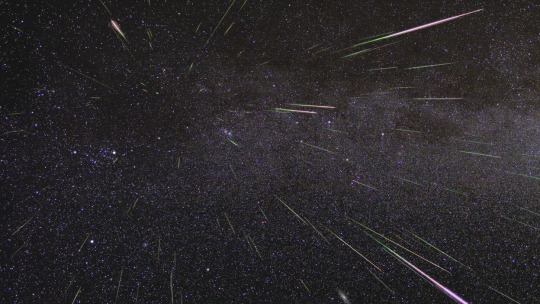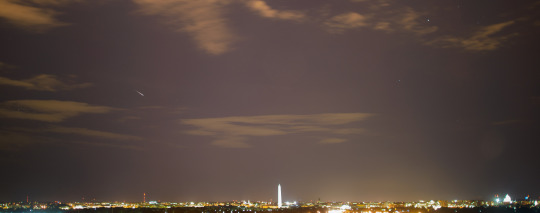Text
The Perseid Meteor Shower Is Here!

Image Credit: NASA/Bill Ingalls
The Perseids are at their peak this week!
The Perseid meteor shower, one of the biggest meteor showers of the year, will be at its brightest early in the morning on Wednesday, August 12. Read on for some tips on how to watch the night sky this week – and to find out: what exactly are the Perseids, anyway?

Credit: NASA/Bill Ingalls
Your best chance to spot the Perseids will be between 2 AM and dawn (local time) the morning of August 12. Find a dark spot, avoid bright lights (yes, that includes your phone) and get acclimated to the night sky.
Your eyes should be at peak viewing capacity after about 30 minutes; though the Moon may block out some of the dimmer meteors, you should still be able to see up to 15-20 an hour. If you’re not an early bird, you can try and take a look soon after sunset (around 9 PM) on the 11th, though you may not see as many Perseids then.

Credit: NASA/MEO
If it’s too cloudy, or too bright, to go skywatching where you are, you can try again Wednesday or Thursday night – or just stay indoors and watch the Perseids online!
Our Meteor Watch program will be livestreaming the Perseids from Huntsville, Alabama on Facebook (weather permitting), starting around 9 p.m. EDT on August 11 and continuing through sunrise.
So… why are they called the Perseids?
Because all of a meteor shower’s meteors have similar orbits, they appear to come from the same place in the sky – a point called the radiant.

The radiant for the Perseids, as you might guess from the name, is in the constellation Perseus, found near Aries and Taurus in the night sky.
But they’re not actually coming from Perseus, right?

Credit: NASA/Joel Kowsky
Right! The Perseids are actually fragments of the comet Swift-Tuttle, which orbits within our solar system.
If you want to learn more about the Perseids, visit our Watch the Skies blog or check out our monthly “What’s Up” video series. Happy viewing!
Make sure to follow us on Tumblr for your regular dose of space: http://nasa.tumblr.com
4K notes
·
View notes
Text

Where are all these meteors coming from? In terms of direction on the sky, the straight answer is the constellation of Perseus- which is why the meteor shower that peaks tomorrow night is known as the Perseids. In other terms though, the Perseids meteors come from Comet Swift-Tuttle. The comet follows a well-defined orbit around our Sun, and the part of the orbit that approaches Earth passes in front of the Perseus constellation. Therefore, when Earth crosses this orbit, the radiant point of falling debris appears in Perseus.
Featured here, a composite image taken over eight nights and containing over 400 meteors from 2018 August's Perseids meteor shower shows many bright meteors that streaked over Kolonica Observatory in Slovakia. This year's Perseids holds promise to be one of the best meteor showers of the year.
Image Credit & Copyright: Petr Horálek
187 notes
·
View notes
Photo

Mercury’s Solar Transit : The planet Mercury is seen in silhouette, low center, as it transits across the face of the Sun, Monday, Nov. 11, 2019. (via NASA)
3K notes
·
View notes
Photo

New results from our Juno mission suggest the planet is home to “shallow lightning.” An unexpected form of electrical discharge, shallow lightning comes from a unique ammonia-water solution.
It was previously thought that lightning on Jupiter was similar to Earth, forming only in thunderstorms where water exists in all its phases – ice, liquid, and gas. But flashes observed at altitudes too cold for pure liquid water to exist told a different story. This illustration uses data obtained by the mission to show what these high-altitude electrical storms look like.
Understanding the inner workings of Jupiter allows us to develop theories about atmospheres on other planets and exoplanets!
Illustration Credit: NASA/JPL-Caltech/SwRI/MSSS/Gerald Eichstädt/Heidi N. Becker/Koji Kuramura
Make sure to follow us on Tumblr for your regular dose of space: http://nasa.tumblr.com
6K notes
·
View notes
Photo

Hubble captures the “delicate feathery nature” of galaxy NGC 2275
726 notes
·
View notes
Photo

Jupiter’s Magnificent Swirling Clouds
via NASA https://ift.tt/2O5QXNx
376 notes
·
View notes
Photo

The moon passed between NASA’s Deep Space Climate Observatory and the Earth, allowing the satellite to capture this rare image of the moon’s far side in full sunlight. As the moon is tidally locked to the Earth and doesn’t rotate, we only ever see the one face from the Earth. Awesome shot!
291K notes
·
View notes
Photo

Comet ISON Otober 9, 2013 by Hubble Heritage
145 notes
·
View notes
Photo

Churning Texture in Jupiter’s Atmopshere by NASA’s Marshall Space Flight Center
112 notes
·
View notes
Photo


Cairo and the Nile by night and day
4000 years have passed since the advent of the Pharaoh, but the River Nile still remains the pulse of Egyptian metropolitan activity. Both images, captured by astronauts from the International Space Station, show the intricacies and breadth of the Nile Delta, as well as the city of Cairo at the delta’s apex. During the day, the Nile Delta appears as a floodplain with prosperous vegetation, in stark contrast to the barren sands of the surrounding desert. At night, the urban network of Cairo shines like the brightest bulb in a chandelier — the metropolis is the largest city in the Middle East and constitutes one-fifth of Egypt’s population. Less luminous are the towns and villages along the Nile Valley and the Nile Delta, but the lights are still bright enough that you can trace the dark lines of the River Nile and the many branches of the Nile Delta that flow into the Mediterranean Sea.
-DC
Photo credits:
https://archive.org/details/PIA02647
https://eol.jsc.nasa.gov/SearchPhotos/photo.pl?mission=ISS025&roll=E&frame=9858
336 notes
·
View notes
Video
youtube
12 MIND-BOGGLING SPACE FACTS
Follow us on youtube: https://www.youtube.com/user/unbfacts
102 notes
·
View notes
Photo

Supernova Remnant Cassiopeia A by Hubble Heritage
258 notes
·
View notes
Text
My very first telescope from my childhood and my current one 💕

79 notes
·
View notes
Photo

It’s not much, but this is the first photograph I took with my first telescope. I’ve been star gazing my life, but it wasn’t until my 30s before I could afford a telescope.
657 notes
·
View notes











